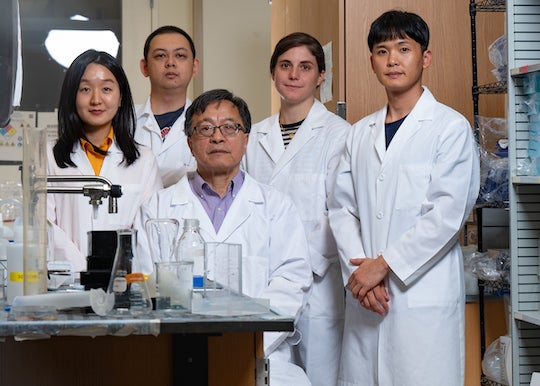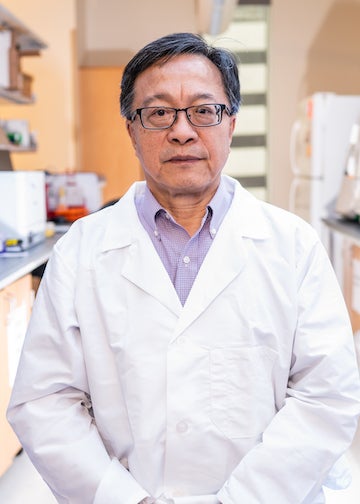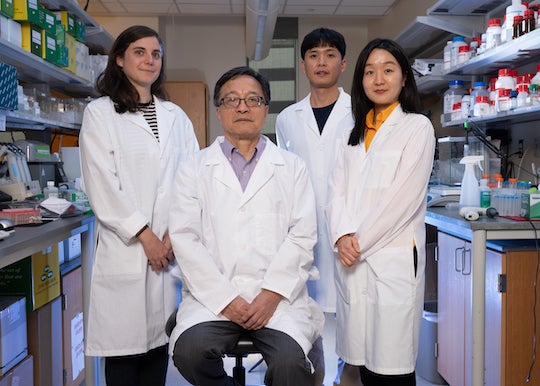Rice University bioengineer Gang Bao and his team have won a 4-year, $2.6 million grant from the National Institutes of Health to address critical questions surrounding the safety and efficacy of using gene editing to treat sickle cell disease.

Because it is caused by a mutation in a single gene, sickle cell disease is a prime candidate for gene editing treatments using tools such as CRISPR-Cas9.
“Sickle cell disease affects over five million people worldwide, and life expectancy ranges from approximately five years in low-resource settings to 40-45 in countries like the U.S.,” Bao said.
Previously, the Bao lab has found that CRISPR-Cas9 does not work as expected, resulting in unintended large deletions and insertions at the Cas9 cut site. He and his team will now direct their efforts to figuring out why these gene modifications occur, what their biological consequences are and what can be done to fix the issue.
“We want to understand the mechanisms that cause these large gene modifications,” Bao said. “For many years, we believed that a CRISPR-Cas9-induced DNA double-strand break only results in small deletions or insertions of less than 50 nucleotides. But we found that these modifications are in fact much larger ⎯ ranging from about 200 to several thousand nucleotides.”

A Cas9 enzyme relies on a CRISPR guide RNA to target the site in the genome where it performs its cut.
“We tested three guide RNA molecules designed to treat sickle cell disease and found that they all had large deletions and insertions at the Cas9 cut-sites in hematopoietic stem and progenitor cells from patients with sickle cell disease,” Bao said. “We also tested a guide RNA designed for editing T cells for immunotherapy, and we found the same thing happens in that context.”
The discovery that CRISPR-Cas9 generates large, unintended gene modifications prompts the question of how these changes affect messenger RNA and proteins, where messenger RNA is a molecule that helps translate the genetic information encoded in genes into proteins which, in turn, are made up of subunits known as domains.
“Now we have a good picture of what happens in terms of the DNA,” Bao said. “Next, we want to understand what happens at the level of messenger RNA and proteins. Does a large DNA deletion lead to disruption of the gene or to a large deletion in the messenger RNA that will in turn produce an incomplete protein? Alternatively, does a large DNA insertion get translated by messenger RNA into a protein with an extra domain?”
Researchers will study how the changes to gene expression and/or protein structure affect stem cell differentiation and function.

“We believe some of the large deletions actually could be beneficial,” Bao said. “Some of these larger deletions could, for instance, induce the expression of fetal hemoglobin, which would help cure sickle cell disease. But we need to do more work to figure out which large deletions might achieve this and how to utilize them for curing sickle cell disease.
“We need to understand the major biological consequences of having these unintended large gene modifications and then figure out how to best address this problem.”
So-Hyun (Julie) Park, a Rice doctoral alum and assistant research professor of bioengineering, made a significant contribution to obtaining the NIH grant. Dr. Cecile Karsenty, clinical fellow in the Department of Pediatrics at the Baylor College of Medicine and at Texas Children’s Hospital, and bioengineering doctoral students Mingming Cao and ByoungYong Yoo generated some of the data for the grant proposal.
Bao is the department chair and Foyt Family Professor of Bioengineering, a professor of chemistry, materials science and nanoengineering, and mechanical engineering, and a CPRIT Scholar in Cancer Research.
- Image Downloads:
-
https://news-network.rice.edu/news/files/2023/07/JF6_6267.jpg
CAPTION: So-Hyun (Julie) Park (from left), Mingming Cao, Gang Bao, Cecile Karsenty and ByoungYong Yoo. (Photo by Jeff Fitlow/Rice University)
https://news-network.rice.edu/news/files/2023/07/JF6_6235.jpg
CAPTION: Cecile Karsenty (from left), Gang Bao, ByoungYong Yoo and So-Hyun (Julie) Park. (Photo by Jeff Fitlow/Rice University)
https://news-network.rice.edu/news/files/2023/07/JF6_6221.jpg
CAPTION: Gang Bao is department chair and Foyt Family Professor of Bioengineering, a professor of chemistry, materials science and nanoengineering, and mechanical engineering, and a CPRIT Scholar in Cancer Research. (Photo by Jeff Fitlow/Rice University) - Related stories:
-
Even good gene edits can go bad:
https://news.rice.edu/news/2022/even-good-gene-edits-can-go-bad
New genetic weapons challenge sickle cell disease:
https://news2.rice.edu/2019/06/03/new-genetic-weapons-challenge-sickle-cell-disease-2/
- Links:
-
Bao Lab: http://bao.rice.edu
Rice Department of Bioengineering: https://bioengineering.rice.edu
George R. Brown School of Engineering: https://engineering.rice.edu
- About Rice:
-
Located on a 300-acre forested campus in Houston, Rice University is consistently ranked among the nation’s top 20 universities by U.S. News & World Report. Rice has highly respected schools of Architecture, Business, Continuing Studies, Engineering, Humanities, Music, Natural Sciences and Social Sciences and is home to the Baker Institute for Public Policy. With 4,552 undergraduates and 3,998 graduate students, Rice’s undergraduate student-to-faculty ratio is just under 6-to-1. Its residential college system builds close-knit communities and lifelong friendships, just one reason why Rice is ranked No. 1 for lots of race/class interaction and No. 4 for quality of life by the Princeton Review. Rice is also rated as a best value among private universities by Kiplinger’s Personal Finance.

